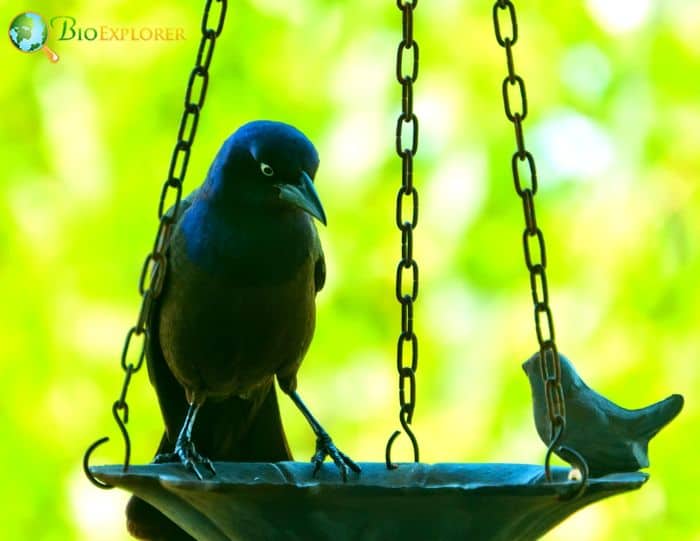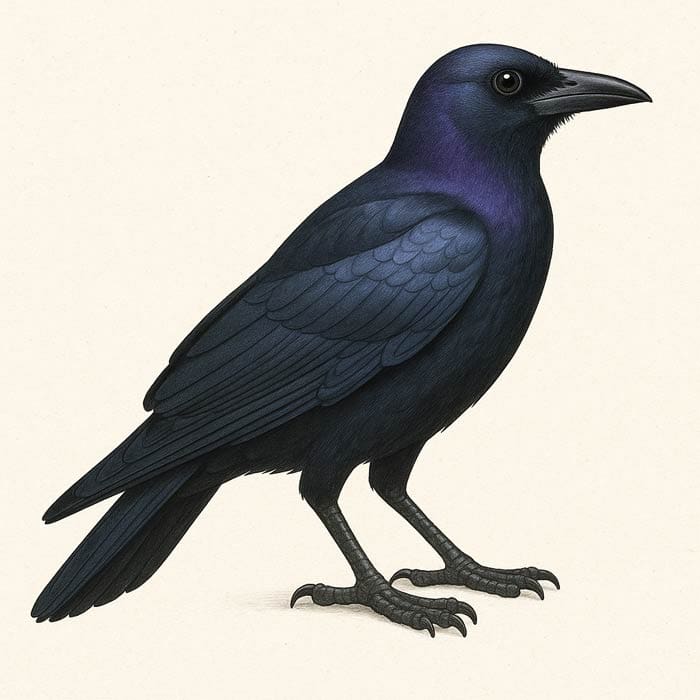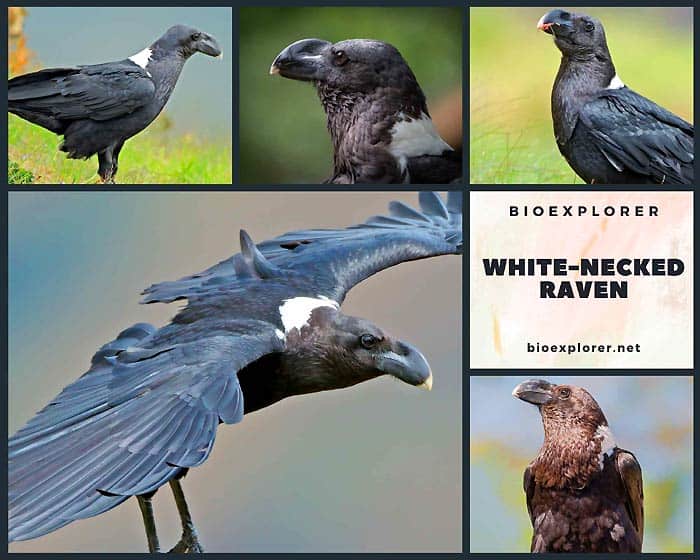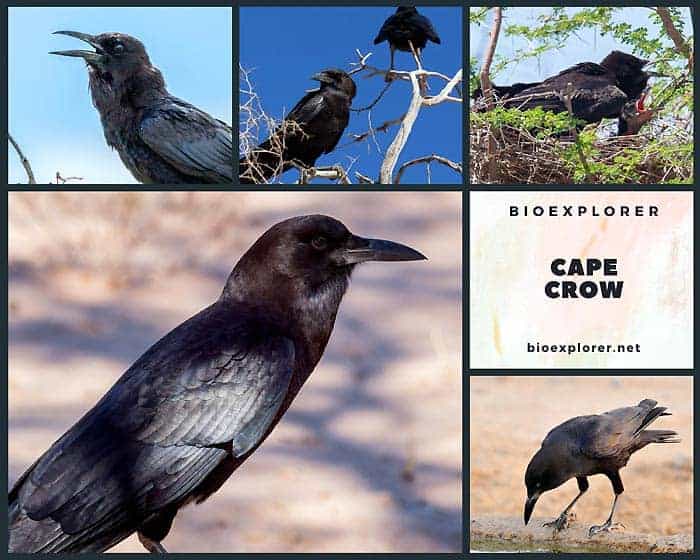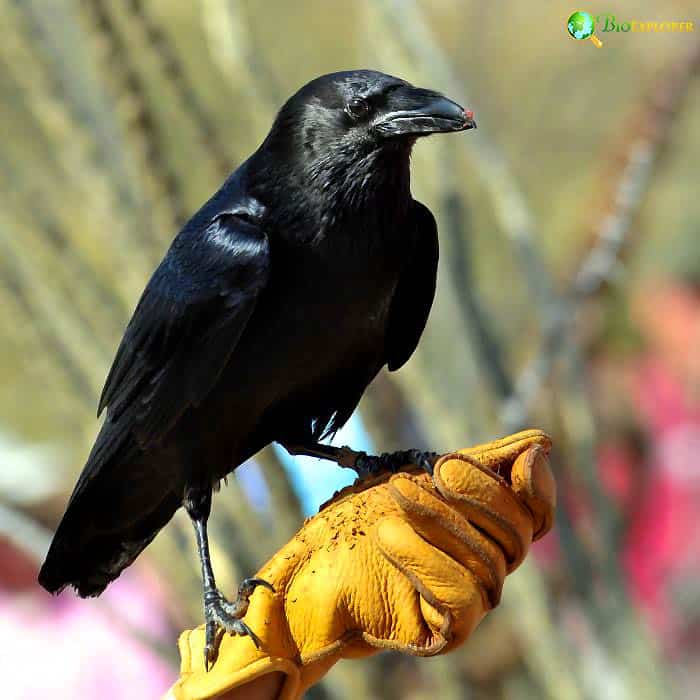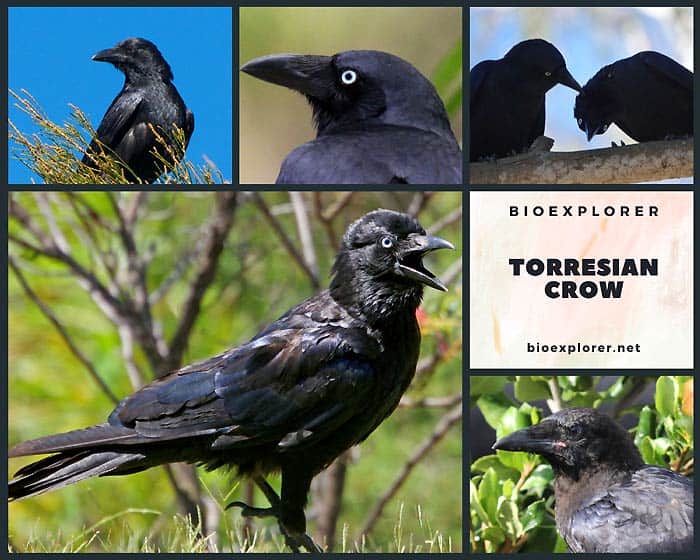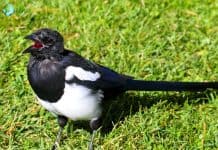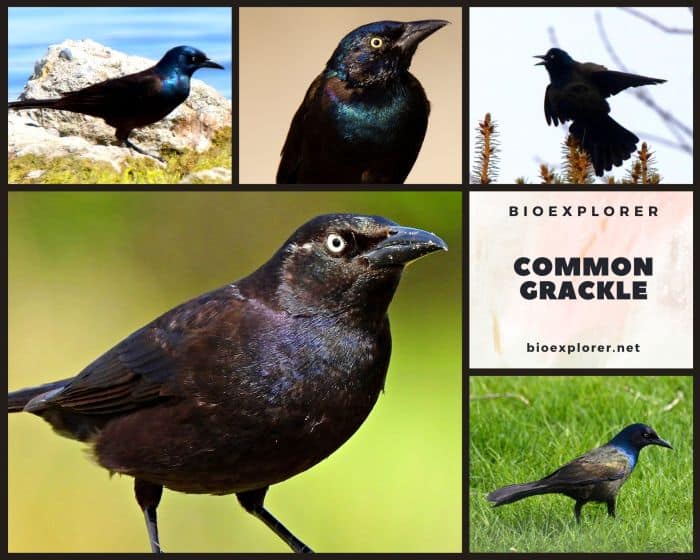
Common Grackles (Quiscalus quiscula) are lanky, fierce-appearing, shiny blackbirds that appear to have been somewhat stretched. Common Grackles are residents of open, wet woodlands and marshes and in suburbia, parks, and agricultural fields.
Table of Contents
Common Grackle Physical Characteristics
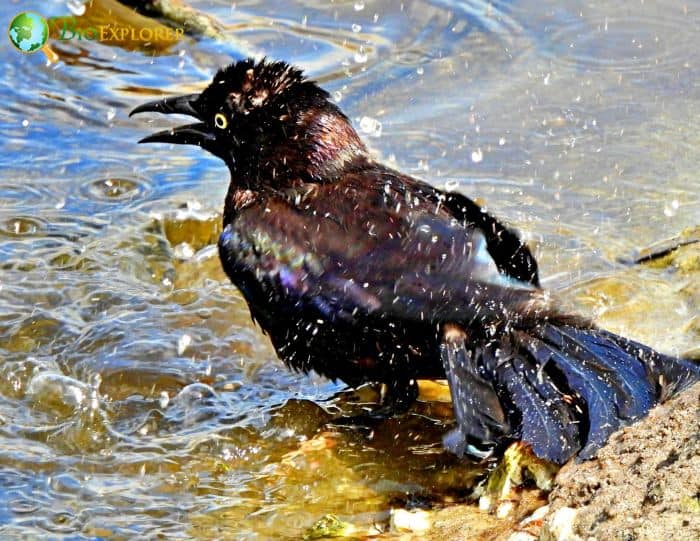
The Common Grackle is a blackbird species known for its larger and lankier physique than most blackbirds.
- They possess long legs and tails, with a flat head and a longer bill that subtly curves downward. As a result, the wings may appear shorter in proportion to the tail.
- Male Common Grackles are slightly larger than females. Their striking glossy purple heads create a contrasting display against their bronzy-iridescent bodies, which, from a distance, may appear black.
- The Grackle’s bright golden eyes contribute to its intent expression. Females[1] have slightly less shine compared to males. Juvenile birds feature dark eyes and dark brown body.
- These medium-sized blackbirds exhibit glossy and iridescent black plumage. Generally, their heads, necks, and breasts generally display a glossy purplish-blue or bluish-green coloration.
- However, the plumage color of Common Grackles can vary across different regions of North America. The subspecies in New England and the Western parts showcase a brassy bronze body color.
- East of the Allegheny Mountains, the body color is purple, while in the Southeast, the feathers exhibit a greenish hue. Common Grackles are equipped with long, sharp, black bills.
Common Grackles Dietary Adaptability
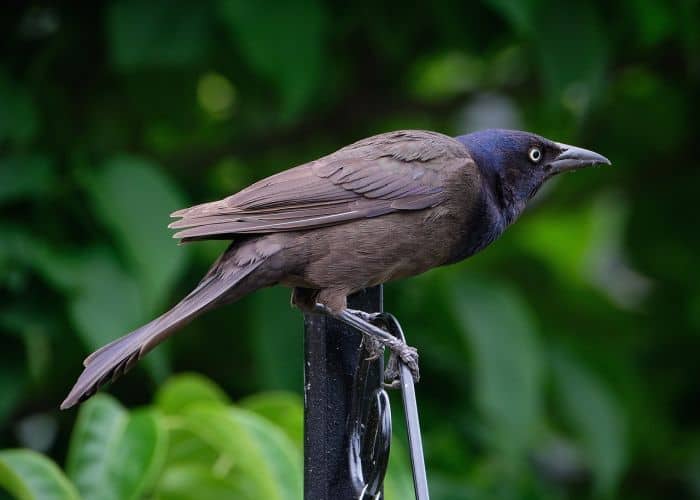
Common Grackles are highly adaptable and display a diverse diet.
- As omnivores, they consume various food items, including insects, minnows, frogs, eggs, berries, seeds, grain, and even small birds and mice. In addition, their foraging skills are remarkable, as they engage in various hunting techniques[2].
- These black birds follow plows to capture invertebrates and mice, wade into the water to catch small fish, pluck leeches off the legs of turtles, steal worms from American robins, raid nests, and even prey on adult birds.
- These active birds are primarily diurnal and spend significant time foraging on the ground, in shallow water, or among shrubs.
- They are opportunistic feeders and have been observed stealing food from other birds.
- Common Grackles eagerly await any chance at outdoor eating areas for food scraps, swiftly snatching dropped morsels or seizing food from the beaks of unsuspecting birds.
- Common Grackles are characterized by their gregarious nature and vocal calls in addition to their foraging behavior.
- They form large flocks, often mingling with other bird species, and engage in migration, nesting, and roosting activities together. Their presence is often accompanied by a lively and noisy atmosphere.
Common Grackles have hard keels
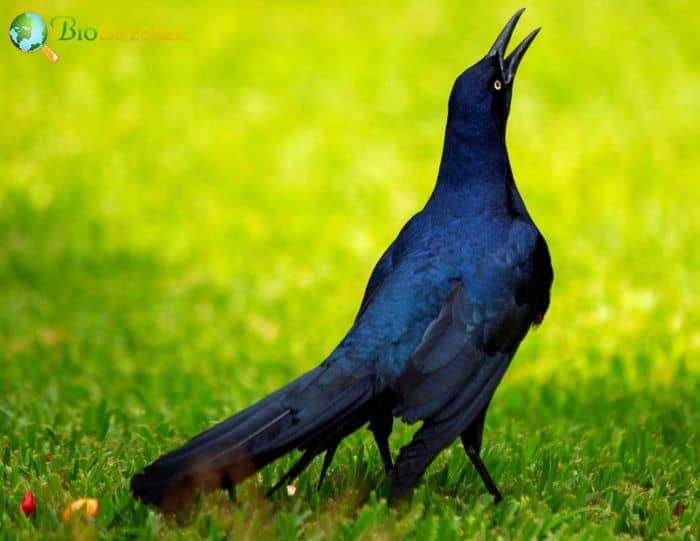
Common Grackles possess a unique adaptation in the form of a hard keel inside their upper mandible.
- This keel, a sharp and rigid ridge extending downward from their hard palate, allows them to efficiently saw open acorns[3]. They typically use this keel to score the outer surface of the narrow end of the acorn before biting it open[4].
- Resourceful and adaptable, Common Grackles exhibit various foraging behaviors. They have been observed following plows to capture invertebrates and mice, wading into the water to catch small fish, removing leeches from the legs of turtles, stealing worms from American Robins, raiding nests, and even preying on adult birds.
- Another intriguing behavior displayed by Common Grackles is anting, where they let ants crawl over their bodies and feathers. This behavior is believed to provide benefits such as ant-derived chemicals that deter parasites or aid in preening.
- These diverse foraging strategies highlight the resourcefulness and adaptability of Common Grackles as they utilize different techniques to obtain food from various sources in their environment.
Common Grackles practice anting
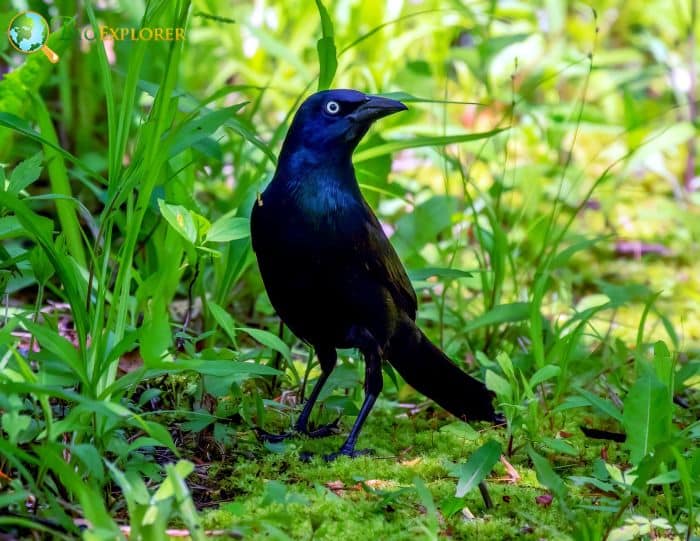
Common Grackles exhibit the fascinating behavior known as anting, where they deliberately expose themselves to fluid-secreting ants or other pungent substances.
- During anting, a grackle will lie on the ground near an ant nest, allowing the ants to crawl over its body and feathers. As a result, the ants release formic acid, the same chemical found in their stings. It may serve as a natural insect repellent or help rid the bird of parasites.
- Besides ants, Common Grackles have been observed utilizing other natural substances on their plumage to potentially deter parasites or insects. These substances include marigold flowers, lemon pieces, walnut juice, and chokecherry juice.
- It is believed that the strong aromas or chemical properties of these items may provide some protective benefits for the grackles by deterring or repelling potential pests.
The anting behavior and the use of various natural insect repellents by Common Grackles demonstrate their resourcefulness in seeking out natural solutions to minimize the presence of parasites or insects on their bodies.
Common Grackles sometimes use pre-built nests
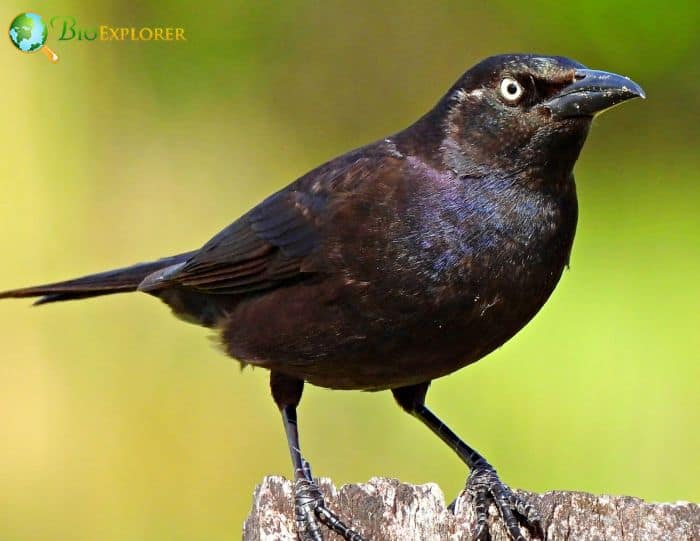
Common Grackles exhibit flexibility in their nesting habits, as they can build their own nests and utilize existing spaces for egg-laying.
- According to the Animal Diversity Web[5], female Common Grackles typically construct nests in coniferous trees. However, they have been observed nesting in various locations, such as woodpecker holes, rafters, barn eaves, ospreys’ nests, and clumps of cattails. In addition, unconventional nesting sites like birdhouses, cliff crevices, and occupied Osprey and Great Blue Herons nests are also occasionally utilized.
- Common Grackles may form small nesting colonies, and multiple males may perch in neighboring treetops, creating a chorus of their distinctive creaking, grating songs.
- During the nesting phase, the male Grackle may guard the nest while the female ventures out to feed. Sometimes, the male may even form a secondary pair bond with a second female during this time. However, it is important to highlight that each nest site typically raises only one brood per breeding season, and second broods are rare.
- In addition, Common Grackles sometimes partake in communal nesting, where multiple individuals lay their eggs in a shared nest. They display minimal territoriality except near the nest.
- This cooperative nesting behavior further exemplifies the social dynamics within Common Grackle populations during the breeding season.
Common Grackles have a harsh voice
Common grackles sing[6] harshly and use vocal communication. Songs range from simple “chewink chewink” to complicated mating season “ooo whew, whew, whew, whew” calls that sound like power lines buzzing.
What Do Common Grackles Eat?
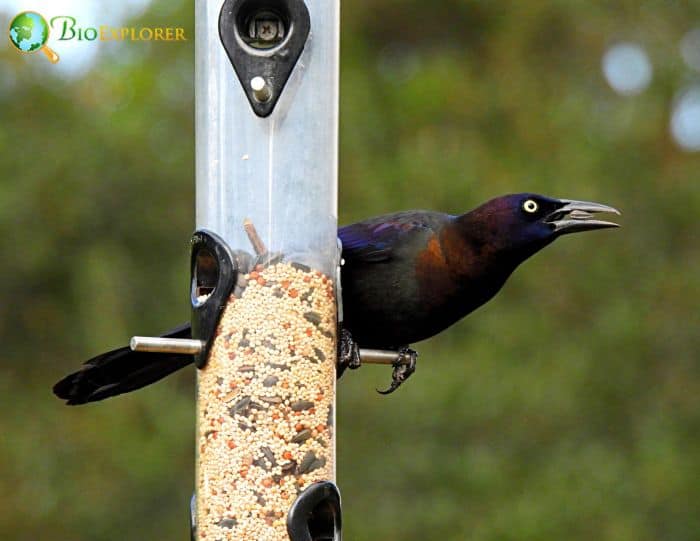
The Common Grackle feeds on[¶] many food sources including but not limited to:
- Sweetgum (Liquidambar styraciflua)
- Angleworms (Oligochaeta)
- Araignées (Araneae)
- Angiosperma (Angiospermae)
- Anole Vert (Anolis carolinensis).
- Borboleta (Lepidoptera)
- Bullbriar (Smilax rotundifolia)
- Asian Bittersweet (Celastrus orbiculatus).
- Flowering Dogwood (Cornus florida).
- Eastern Poison Ivy (Toxicodendron radicans).
- Chinese Honeysuckle (Lonicera japonica).
- Northern Spicebush (Lindera benzoin).
- American Pokeweed (Phytolacca americana).
- Bristly Greenbrier (Smilax tamnoides).
- Fox Grape (Vitis vulpina).
- American Ivy (Parthenocissus quinquefolia).
- Canadian Moonseed (Menispermum canadense).
- Black Cherry (Prunus serotina).
- Sassafras (Sassafras albidum)
- Angelicatree (Aralia spinosa)
- Graybark Grape (Vitis cinerea).
- Garceta Verde (Butorides virescens).
- Ampelis Chinito (Bombycilla cedrorum).
- Bluntnose Minnow (Pimephales notatus).
- Chevalier Grivelé (Actitis macularius).
- Corn (Zea mays)
- Ants (Formicidae)
- Charançons (Curculionidae)
- Carabes (Carabidae)
- Grapes (Vitaceae)
- Hexapoda (Insecta)
- Hawk Moths (Sphingidae)
- Scentless Plant Bugs (Rhopalidae).
- Gongolo (Diplopoda)
- Graminées (Poaceae)
- Molluscs (Mollusca)
- Grasshoppers (Acrididae)
- Arthropodes (Arthropoda)
- Animal (Animalia)
- Tracheophytes (Tracheophyta)
- Crickets (Orthoptera)
- Beetles (Coleoptera)
- Mamífero (Mammalia)
- Sunflower (Helianthus)
- Centipedes (Chilopoda)
- Chêne (Quercus)
- Aleppo Milletgrass (Sorghum halepense).
- Bristlegrass (Setaria)
- Crabgrass (Digitaria)
- Knotweed (Polygonum)
- Canada Cocklebur (Xanthium strumarium).
- Pokeweed (Phytolacca)
- Wheat (Triticum)
- Rice (Oryza sativa)
- Oat (Avena)
- Pacific Poison Oak (Toxicodendron diversilobum).
What Eats Common Grackles?
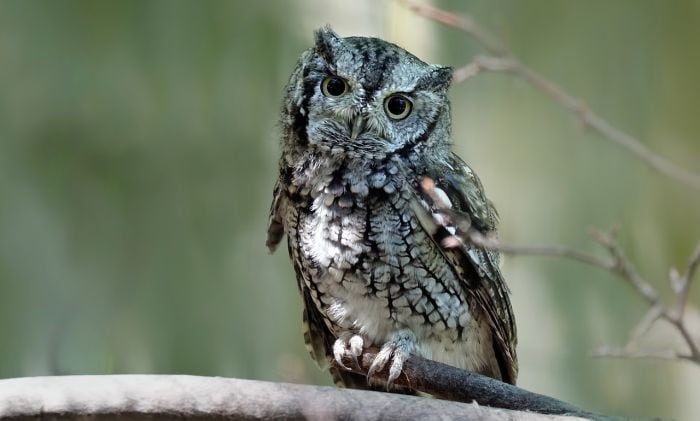
The Common Grackles have many natural predators including[§]:
Búho Cornudo (Bubo virginianus), Águila Cabeza Blanca (Haliaeetus leucocephalus), eastern screech owl (Megascops asio), Barred Owl (Strix varia), Aguililla Pecho Rojo (Buteo lineatus), Autour Des Palombes (Accipiter gentilis), Cooper’s Hawk (Accipiter cooperii), Barn Owl (Tyto alba) and American Kestrel (Falco sparverius).
Other Black Birds
